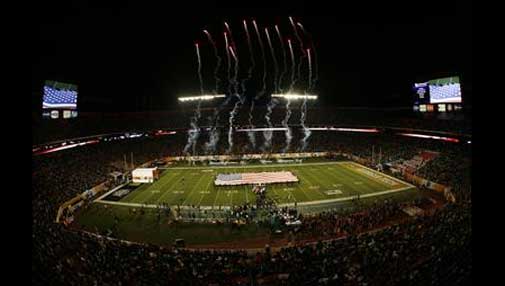
College football bowl season doesn't burst onto the TV scene as much as it simply ooozes into our collective consciousness. Lots of factors come into play...
The bowls don't have the convenient packaging of the ballyhooed March Madness, with office pools so prevalent that many are played intramural at police headquarters. The bowls do not, for example, have the many Cinderella stories boasted by the Road to the Final Four, which, by the by, is another bit of clever packaging proffered by CBS.
But what the college bowls lack in wrapping, promotions and the very certainty that the last team standing is an unquestionable national champion, they more than make up for in sheer volume.
Make sure your lounge chair is feng shui in relation to the giant-screen TV. Arrange for the coldest beer and the hottest wings. And keep an unobstructed path to the necessary room so as to hold interruptions to a minimum.
The New Mexico Bowl, which pits Brigham Young University against the University of Texas-El Paso, kicks off at noon ET Saturday on ESPN, and the bowl season is on. Crowd this into your mind: 35 bowl games will be played in 23 days.
Does that mean a talent bonanza for college football fans? Not necessarily. Because once the NCAA added a 12th game to the college football schedule, teams can win six games and attain what broadcasters like to refer to as bowl eligibility.
That said, 17 of the teams who'll take part in the post-season won seven games; 12 teams won the minimum six. Many among them finished in such lackluster fashion that their coaches are begging fans to buy bowl tickets.
The sheer number of bowls has created college football's version of "everybody gets a trophy." It's the same dilution of competition in youth leagues that has left a generation unable to cope with adversity. In the case of way too many bowls, you can pretty well count on television being the culprit.
Nearly every one of the teams of a lesser bowl will be seen on ESPN. That's good and bad.
Obviously, it's good for the teams to get some national exposure. It's bad that some of those teams have such mediocre records that bowl audiences will need to down excitement pills to get through the games. And, note to the game broadcasters: be sure the cameras don't scan the stands at many of the peripheral bowls. It's not unusual for the weather to be awful and the fan interest to be minimal enough to keep boosters in the warmth -- watching the games, well, on TV.
The handful of bowls played in sunny, resort destinations in stadiums filled by the year-round work of fervent civic organizations have given way to corporate-sponsored bowls whose names sometimes belie a bowl's longstanding presence.
The Orange Bowl, for example, has changed corporate so many times, I'm reluctant to mention the full name, for fear of a change by press time.
I plan to wear a pinstripe suit as I watch the Humanitarian Bowl. I think it's only fitting and proper for a bowl with such a lofty name. The Beef O'Brady's Bowl already has me hungry. And if either the Utah band or the Boise State band offers a tribute to Earl Schieb at halftime during the MAACO Bowl, they will surpass the Stanford band in raw chutzpah.
The Hawaii Bowl makes sense for Tulsa, but why is the University of Hawaii hogging the home turf? Why can't the Rainbow Warriors pack for Shreveport, La., and give the Air Force Academy or Georgia Tech a shot at Honolulu?
With payouts that range from $300,000 (BBVA Compass Bowl, featuring Pittsburgh vs. Kentucky in Birmingham, Ala.) to $18 million in the BCS Championship game Jan. 10 in Glendale, Ariz., 70 athletic directors will have logistical nightmares. The schools getting the small payoffs might actually spend more money to get teams, bands and boosters to the bowl than the game pays.
For teams bound for bowls Rose, Fiesta, Orange, Sugar and BCS title -- all of which pay $18 million -- the largesse comes with the headache of dividing money, tickets, travel and access for legions of fans.
Other than the Woodstock guilty pleasure of staking claim to actually being in the bowl city and in the bowl stadium, it's probably a very good thing that ESPN will make them available to fans who will take the road less traveled.
What a wonderful holiday feast.